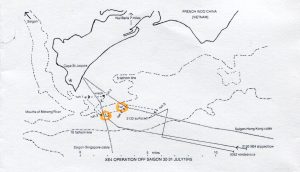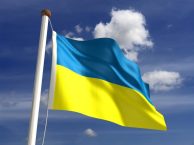
First RAN Operation off Vũng Tàu – the XE-4 midget submarine, July 1945
 In mid-1945, the Japanese principal military headquarters in Saigon – HQ of the Southern Expeditionary Area Army Group was responsible for all Japanese military operations in South East Asia and the South-West Pacific. It was connected to Singapore and to Hong Kong by pre-War II undersea telegraph cables. Consequently, Allied signals intercept operations were unable to access a large amount of important Japanese signals traffic. At US initiative (Operation Sabre), a plan was developed for Royal Navy/Royal Australian Navy divers – from a midget-submarine, to cut these cables underwater. The plan was for a British midget submarine to drag grapnels and hook the cables in the shallow waters off Vũng Tàu – then divers would emerge from the midget submarine and cut the cables. Six modified British XE midget submarines were brought to Australia by a mother ship – HMS Bonaventure. During practice dives in Hervey Bay (Queensland), two British divers lost their lives in the “work-up” training exercises. Subsequently, the operation was launched from Brunei Bay (off Labuan) – as Task Group 71.11 of the US Seventh Fleet, from where the a British “mother” S-class submarine (HMS Spearhead, 217 feet) towed the XE-4 midget submarine into the South China Sea towards the coast of southern Vietnam. The XE-4 crew comprised Lieutenant Max Shean RANVR – commanding, Sub Lieutenant Bernard Kelly RNVR, Sub Lieutenant Adam Bergius RNVR, Sub Lieutenant Kenneth Briggs RANVR, and Engine Room Artificer Vernon Coles RN.
In mid-1945, the Japanese principal military headquarters in Saigon – HQ of the Southern Expeditionary Area Army Group was responsible for all Japanese military operations in South East Asia and the South-West Pacific. It was connected to Singapore and to Hong Kong by pre-War II undersea telegraph cables. Consequently, Allied signals intercept operations were unable to access a large amount of important Japanese signals traffic. At US initiative (Operation Sabre), a plan was developed for Royal Navy/Royal Australian Navy divers – from a midget-submarine, to cut these cables underwater. The plan was for a British midget submarine to drag grapnels and hook the cables in the shallow waters off Vũng Tàu – then divers would emerge from the midget submarine and cut the cables. Six modified British XE midget submarines were brought to Australia by a mother ship – HMS Bonaventure. During practice dives in Hervey Bay (Queensland), two British divers lost their lives in the “work-up” training exercises. Subsequently, the operation was launched from Brunei Bay (off Labuan) – as Task Group 71.11 of the US Seventh Fleet, from where the a British “mother” S-class submarine (HMS Spearhead, 217 feet) towed the XE-4 midget submarine into the South China Sea towards the coast of southern Vietnam. The XE-4 crew comprised Lieutenant Max Shean RANVR – commanding, Sub Lieutenant Bernard Kelly RNVR, Sub Lieutenant Adam Bergius RNVR, Sub Lieutenant Kenneth Briggs RANVR, and Engine Room Artificer Vernon Coles RN.
XE-4 was towed by the HMS Spearhead submarine to within 40 miles of the release point off the Cap St. Jacques (ie Vũng Tàu) Lighthouse; where XE-4 “slipped her tow”. In the early hours of 31 July 1945, Lieutenant Shean expertly navigated the XE-4 into the waters off Vũng Tàu – taking a bearing on Mount Baria – ie “Nui Baria” (ie: Núi Dinh/Núi Thị Vải noted on the attached map); and submerged to start the long trawl for the cable – the water was about 15 metres deep. “After several hours dragging, on the third attempt at about 1236 hours, XE-4 snagged the Singapore-to-Saigon cable. XE-4’s first diver – Sub Lieutenant Ken Briggs RANVR, exited the submarine and used a net/cable-cutter to cut it – bringing a 12- inch length back into the submarine, as proof of the cut. Dragging was re-commenced, and the Saigon-to- Hong Kong cable was found soon afterwards at about 1400 hours. “The second diver – Sub Lieutenant Adam Bergius RNVR, exited XE-4 – but his cable-cutter failed to work, so he re-entered the submarine and exchanged cutters, taking a brief rest as well, before re-exiting and finishing the job.” XE-4 then linked-up with the waiting submarine (HMS Spearhead), and three days later joined HMS Bonaventure in Labuan on 3 August 1945. Lieutenant Shean was awarded a bar to his DSO, and DSCs were awarded to the young divers Briggs and Bergius.
The first atomic bomb was dropped on Hiroshima a few days later on 6 August 1945.
Reference: Shean, M., autobiography – Corvette and Submarine, Claremont WA, self[1]published, 1992, deceased 2009. Including inserted map “XE4 Off Saigon” at p.252




